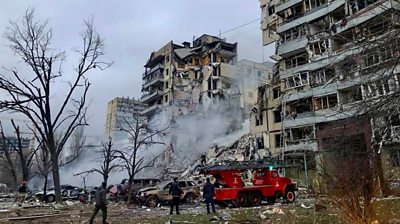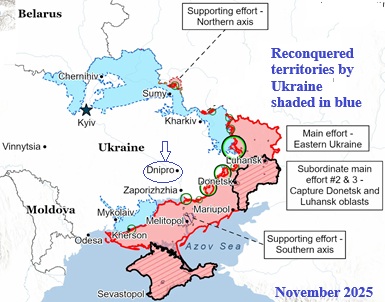- This is a civilian target far away from the front lines.
 Dnipro, Nov.18.— A city of 1.1 million, Dnipro (also known as Dnipropetrovs'k) sits on the banks of the Dnieper River in Eastern Ukraine. It’s 650 miles from the Polish border at Chelm. On the northwest approaches to this city, which is the country’s fourth largest and a six-hour drive from the capital, Kyiv, a car can speed down a road which in many ways is more pleasant than I-95 between Washington and New York. From this modern, divided highway, huge fields of plowed black earth alternate with even more massive fields of wheat alongside tidy farmhouses. Until you reach the little town of Tsybulivka in Poltava Oblast, it all looks remarkably like the flat steppes of eastern Kansas.
Dnipro, Nov.18.— A city of 1.1 million, Dnipro (also known as Dnipropetrovs'k) sits on the banks of the Dnieper River in Eastern Ukraine. It’s 650 miles from the Polish border at Chelm. On the northwest approaches to this city, which is the country’s fourth largest and a six-hour drive from the capital, Kyiv, a car can speed down a road which in many ways is more pleasant than I-95 between Washington and New York. From this modern, divided highway, huge fields of plowed black earth alternate with even more massive fields of wheat alongside tidy farmhouses. Until you reach the little town of Tsybulivka in Poltava Oblast, it all looks remarkably like the flat steppes of eastern Kansas.
At that point, however, you turn right and south off the main road and into a landscape every bit as  agriculturally rich but more visibly post-Soviet. The road becomes potholed and rough (though perhaps not as rough as some of the country roads back home in Oklahoma), and the developed highway and periodic truck stops that could pass for a Wawa give way to little towns and villages of houses built of painted cinderblock and tin roofs and workshops made of corrugated iron.
agriculturally rich but more visibly post-Soviet. The road becomes potholed and rough (though perhaps not as rough as some of the country roads back home in Oklahoma), and the developed highway and periodic truck stops that could pass for a Wawa give way to little towns and villages of houses built of painted cinderblock and tin roofs and workshops made of corrugated iron.
Driving through at the slower speed of real life, you see parents walking their kids to school in the mist and drizzle of a November morning. You see old women in their gardens. And you see the war memorials. You see the town cemeteries with fresh graves and the little blue and yellow Ukrainian flags.
The city of Dnipro itself is grim. From the far side of the river, you see rows and rows of massive grey apartment blocks. You see industrial buildings and decay. You see gaudy signs advertising karaoke and hookah and prepaid cellphone cards. The people are bundled up to keep out the cold. It’s grey and gritty the way Detroit looks in mid-November.
(...)
[ Full text ]
Comments powered by CComment